

|
| DEUTSCHLAND | GERMANY |
| Bundesland: Niedersachsen | Lower Saxony |
| Landkreis: Cuxhaven |
Cuxhaven is situated on the shore of the North Sea at the mouth of Elbe river. Cuxhaven ist the administrative seat of the district Cuxhaven and has a population of about 55,000.
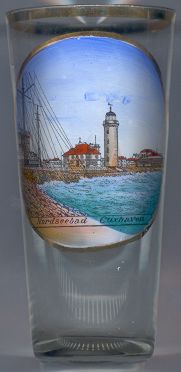 In 1394 castle Ritzebüttel came in possession of Hamburg.
The village of Cuxhaven was first mentioned around 1577
(Dikshave, Kuckshafen, Kuxhaven, Kuckshagen, Kokeshagen, Ritzebutler Have).
In 1810/1811, during the Napoleonic times, Cuxhaven became part of the département Bouches-de-l'Elbe (capital Hambourg, i.e. Hamburg),
which existed until 1814.
The villages Ritzebüttel and Cuxhaven were merged in 1872.
Cuxhaven remained part of Hamburg until the Greater Hamburg Act (Groß-Hamburg-Gesetz, Gesetz über Groß-Hamburg und andere Gebietsbereinigungen, Law regarding Larger Hamburg and other territorial readjustments) of 1937.
The Prussian communities of Harburg-Wilhelmsburg, Altona/Elbe and others became part of Hamburg,
while Cuxhaven became part of the Prussian province Hannover. Parts of the port
of Cuxhaven, however, remained a property of the city of Hamburg.
The harbour was enlarged in 1892 to become a port of the Imperial German Navy.
The community of Döse (see below) was incorporated into Cuxhaven in 1805, and two years later the new community of Cuxhaven was incorporated as a city.
Between 1935 and 1972 several of the neighbouring communities were incorporated into Cuxhaven.
In 1969, the islands of Neuwerk and Scharhörn together with the surrounding tidelands were returned to Hamburg.
Cuxhaven remained an independent city until 1977 when it was incorporated into the district Cuxhaven.
Nevertheless, Cuxhaven has a special status within the district ('große selbständige Stadt', 'large autonomous city').
In 1394 castle Ritzebüttel came in possession of Hamburg.
The village of Cuxhaven was first mentioned around 1577
(Dikshave, Kuckshafen, Kuxhaven, Kuckshagen, Kokeshagen, Ritzebutler Have).
In 1810/1811, during the Napoleonic times, Cuxhaven became part of the département Bouches-de-l'Elbe (capital Hambourg, i.e. Hamburg),
which existed until 1814.
The villages Ritzebüttel and Cuxhaven were merged in 1872.
Cuxhaven remained part of Hamburg until the Greater Hamburg Act (Groß-Hamburg-Gesetz, Gesetz über Groß-Hamburg und andere Gebietsbereinigungen, Law regarding Larger Hamburg and other territorial readjustments) of 1937.
The Prussian communities of Harburg-Wilhelmsburg, Altona/Elbe and others became part of Hamburg,
while Cuxhaven became part of the Prussian province Hannover. Parts of the port
of Cuxhaven, however, remained a property of the city of Hamburg.
The harbour was enlarged in 1892 to become a port of the Imperial German Navy.
The community of Döse (see below) was incorporated into Cuxhaven in 1805, and two years later the new community of Cuxhaven was incorporated as a city.
Between 1935 and 1972 several of the neighbouring communities were incorporated into Cuxhaven.
In 1969, the islands of Neuwerk and Scharhörn together with the surrounding tidelands were returned to Hamburg.
Cuxhaven remained an independent city until 1977 when it was incorporated into the district Cuxhaven.
Nevertheless, Cuxhaven has a special status within the district ('große selbständige Stadt', 'large autonomous city').
Since the foundation of the North Sea spa in 1816 Cuxhaven als is a tourist loaction. The picture on glass no. 1970 [left] is labelled Nordseebad Cuxhaven ('North Sea spa Cuxhaven'). More than 3 million tourist-nights are counted each year. Cuxhaven, more precisely its town districts of Duhnen (see below), Döse and Grimmershörn, obtained the status of a state-recognized North Sea therapeutic spa.
The  light-house [left]
was built in 1802–1805. It replaced the former wooden constructions which since the 15th century had marked the Elbe estuary.
In 1899 the German physicist Karl Ferdinand Braun used the light-house to perform experiments on wireless telegraphy.
For his achievements in this area Braun in 1909 was awarded the Nobel Prize (together with Guglielmo Marconi).
The light-house remained in service until 2001 and was sold to a private owner in 2002.
light-house [left]
was built in 1802–1805. It replaced the former wooden constructions which since the 15th century had marked the Elbe estuary.
In 1899 the German physicist Karl Ferdinand Braun used the light-house to perform experiments on wireless telegraphy.
For his achievements in this area Braun in 1909 was awarded the Nobel Prize (together with Guglielmo Marconi).
The light-house remained in service until 2001 and was sold to a private owner in 2002.
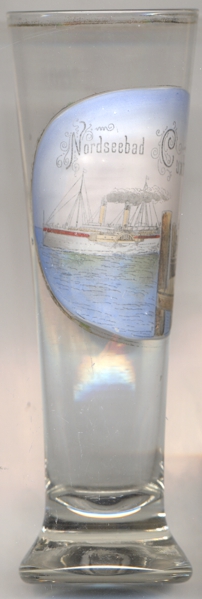
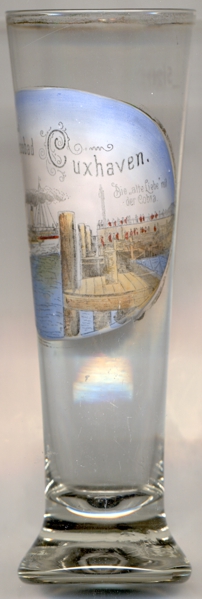
The picture on glass no. 4351 [near left] is labeled Die „Alte Liebe“ mit der Cobra (‘the ‘Alte Liebe’ with the Cobra’):
The  Alte Liebe ('Old Love') is a former pier in the port of Cuxhaven, which today serves as a viewing platform.
It is located on the upstream boundary of the Cuxhaven port to the Lower Elbe fairway. The ships to Neuwerk and Helgoland
as well as to the sandbanks with the seals cast off near the platform towards the port.
The structure was first built in 1733 by sinking three disused ships at this point. The ships were surrounded with piles and the spaces between them
were filled with stones and bushes. The aim was to fortify the harbor damaged by storm surges and to secure the Great Beacon, which at the time marked
the entrance to the harbour. The Alte Liebe later served as a pier and was regularly renovated. In 1982, the building was converted into a pure viewing
platform. At the same time, the dilapidated wooden posts of the substructure were replaced with a construction made of reinforced concrete.
The name Alte Liebe is said to derive from the foremost of the three sunken ships, which was called Die Liebe. According to another
tradition, the name of the ship was Olivia. However, the population only called it Oliv, which corresponded phonetically to the
Low German expression Ol' Liev, meaning 'old love'.
Alte Liebe ('Old Love') is a former pier in the port of Cuxhaven, which today serves as a viewing platform.
It is located on the upstream boundary of the Cuxhaven port to the Lower Elbe fairway. The ships to Neuwerk and Helgoland
as well as to the sandbanks with the seals cast off near the platform towards the port.
The structure was first built in 1733 by sinking three disused ships at this point. The ships were surrounded with piles and the spaces between them
were filled with stones and bushes. The aim was to fortify the harbor damaged by storm surges and to secure the Great Beacon, which at the time marked
the entrance to the harbour. The Alte Liebe later served as a pier and was regularly renovated. In 1982, the building was converted into a pure viewing
platform. At the same time, the dilapidated wooden posts of the substructure were replaced with a construction made of reinforced concrete.
The name Alte Liebe is said to derive from the foremost of the three sunken ships, which was called Die Liebe. According to another
tradition, the name of the ship was Olivia. However, the population only called it Oliv, which corresponded phonetically to the
Low German expression Ol' Liev, meaning 'old love'.
[https://de.wikipedia.org/wiki/Alte_Liebe_(Cuxhaven)]
The side-paddle steamer  Cobra [near left, no. 4351: background left]
served the German seaside resorts service to Helgoland and Sylt (e.g. Westerland) from 1890.
The ship was launched in 1889 at the Fairfield Shipbuilding & Engineering Company yard in Govan, Glasgow. The ship was 80.7 m long and 10.1 m
wide (excluding the wheel arches ) and was measured at 987 GRT. She had room for 912 deck passengers. Her speed was 14.5 knots. In 1910, the
Cobra was significantly rebuilt and modernized, making her nearly as fast as the 20-knot steam turbine ship Kaiser (see
Hamburg), commissioned by HAPAG in 1905. With the outbreak of the World War I, the seaside resort service came to a
standstill. After the end of the war, the Cobra was awarded to France as war reparations in 1919, but was reacquired by HAPAG in 1920 and used again on
its old route until December 1921. Then she was sold to Mahr & Beyer in Wismar for scrapping and was scrapped in 1922.
Cobra [near left, no. 4351: background left]
served the German seaside resorts service to Helgoland and Sylt (e.g. Westerland) from 1890.
The ship was launched in 1889 at the Fairfield Shipbuilding & Engineering Company yard in Govan, Glasgow. The ship was 80.7 m long and 10.1 m
wide (excluding the wheel arches ) and was measured at 987 GRT. She had room for 912 deck passengers. Her speed was 14.5 knots. In 1910, the
Cobra was significantly rebuilt and modernized, making her nearly as fast as the 20-knot steam turbine ship Kaiser (see
Hamburg), commissioned by HAPAG in 1905. With the outbreak of the World War I, the seaside resort service came to a
standstill. After the end of the war, the Cobra was awarded to France as war reparations in 1919, but was reacquired by HAPAG in 1920 and used again on
its old route until December 1921. Then she was sold to Mahr & Beyer in Wismar for scrapping and was scrapped in 1922.
[https://de.wikipedia.org/wiki/Cobra_(Schiff,_1889)]
Several glasses of this collection show other ships.
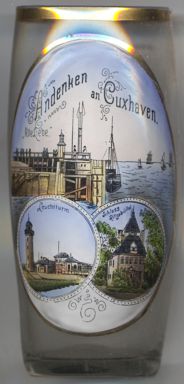
 Schloss Ritzebüttel [nearleft, no. 4561: bottom right picture]
goes back to a tower house built in 1340 for the bailiffs of the duchy of Saxe-Lauenburg. After disputes with the city of
Hamburg and a subsequent siege by the Hanseatic city in 1393, the castle passed into the possession of Hamburg in 1394. For more
than 500 years, the castle was the seat of the Hanseatic magistrates. In 1864, the judiciary and administration of the office were separated, and the
Hamburg magistrates lost much of their influence. In 1937, as part of the Greater Hamburg Act, Cuxhaven was finally traded to Prussia for
Altona, Harburg-Wilhelmsburg and Wandsbek (all part of Hamburg today), and the castle finally lost its political importance. Until 1981 the building was used for
various purposes. At that time the castle was in poor condition and in dire need of renovation. The renovation work, which was repeatedly delayed due to
lack of money, lasted until 1996. The castle was opened to the public with a new usage concept and today houses, among other things, a restaurant, exhibition
rooms and a wedding room.
Schloss Ritzebüttel [nearleft, no. 4561: bottom right picture]
goes back to a tower house built in 1340 for the bailiffs of the duchy of Saxe-Lauenburg. After disputes with the city of
Hamburg and a subsequent siege by the Hanseatic city in 1393, the castle passed into the possession of Hamburg in 1394. For more
than 500 years, the castle was the seat of the Hanseatic magistrates. In 1864, the judiciary and administration of the office were separated, and the
Hamburg magistrates lost much of their influence. In 1937, as part of the Greater Hamburg Act, Cuxhaven was finally traded to Prussia for
Altona, Harburg-Wilhelmsburg and Wandsbek (all part of Hamburg today), and the castle finally lost its political importance. Until 1981 the building was used for
various purposes. At that time the castle was in poor condition and in dire need of renovation. The renovation work, which was repeatedly delayed due to
lack of money, lasted until 1996. The castle was opened to the public with a new usage concept and today houses, among other things, a restaurant, exhibition
rooms and a wedding room.
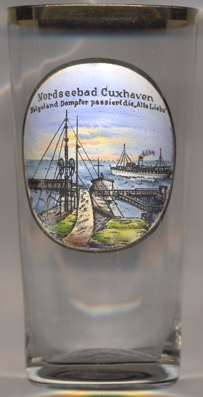 The picture on glass no. 4252 [near left] is labeled Helgoland Dampfer passiert die „Alte Liebe“ (‘Steamer Helgoland passes the “Alte Liebe”’):
The picture on glass no. 4252 [near left] is labeled Helgoland Dampfer passiert die „Alte Liebe“ (‘Steamer Helgoland passes the “Alte Liebe”’):
The sea-resort ship  Helgoland [near left, no. 4252: background right]
was built in 1939 as a turbo electric ship by the F. Lindenau shipyard in Memel (today Klaipėda, Lithuania)
for the Hamburg–America Line (HAPAG). It was the largest ship ever built until then with Voith-Schneider propulsion,
a propulsion device that was also suitable for steering the ship. However, this type of propulsion did not prove itself on the Helgoland. This
was the reason why at the beginning of World War II the ship was not converted into a minelayer, as planned by the Reichsmarine, but was stationed
in Cuxhaven as a naval barge. At the beginning of June 1945, the former seaside resort ship had to be handed over to Great Britain as reparations.
Stationed still in Cuxhaven, the ship burned out in 1946. Until 1947, the Helgoland was at the Deutsche Werft in Hamburg-Finkenwerder.
The ship was finally sunk in the North Sea on the orders of the Allies in 1948.
Helgoland [near left, no. 4252: background right]
was built in 1939 as a turbo electric ship by the F. Lindenau shipyard in Memel (today Klaipėda, Lithuania)
for the Hamburg–America Line (HAPAG). It was the largest ship ever built until then with Voith-Schneider propulsion,
a propulsion device that was also suitable for steering the ship. However, this type of propulsion did not prove itself on the Helgoland. This
was the reason why at the beginning of World War II the ship was not converted into a minelayer, as planned by the Reichsmarine, but was stationed
in Cuxhaven as a naval barge. At the beginning of June 1945, the former seaside resort ship had to be handed over to Great Britain as reparations.
Stationed still in Cuxhaven, the ship burned out in 1946. Until 1947, the Helgoland was at the Deutsche Werft in Hamburg-Finkenwerder.
The ship was finally sunk in the North Sea on the orders of the Allies in 1948.
[https://maritime-photographie.de/img/3871]
Several glasses of this collection show other ships.
![3359 Cuxhaven [Döse]](glas3359.jpg)
The three pictures on glass. 3359 [left, no. 3359] are labeled Deichpartie ('At the dyke') [top picture], Kugelbake ('Ball beakon'; see below) [bottom left picture], and Wattenlaufen ('Mudflat walking') [bottom right picture].
![3538 Cuxhaven [Döse]: Kugelbake](glas3538.jpg)
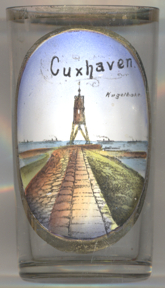
The  Kugelbake (Ball Beacon) [near left, no. 3538, and right, no. 3055]
is a historic aid to navigation in Cuxhaven, located where the River Elbe flows into the North Sea. The Kugelbake is the
principal landmark of Cuxhaven; since 1913, it has been depicted on the city’s coat of arms. Large wooden structures
guiding mariners have stood on this spot for over 300 years. The Kugelbake stands at a busy shipping lane in the Cuxhaven
borough of Döse and was once a vital nautical landmark. At this point, the estuary is about 18 km wide. Geographically
speaking, the Elbe ends here and the North Sea begins. From a nautical point of view, the Kugelbake can be said to separate
the Outer and Lower sections of the Elbe. It is also regarded as the symbolic separation between the Elbe and Weser estuaries.
Its distinctive design, well known to skippers, is now a popular tourist destination.
Kugelbake (Ball Beacon) [near left, no. 3538, and right, no. 3055]
is a historic aid to navigation in Cuxhaven, located where the River Elbe flows into the North Sea. The Kugelbake is the
principal landmark of Cuxhaven; since 1913, it has been depicted on the city’s coat of arms. Large wooden structures
guiding mariners have stood on this spot for over 300 years. The Kugelbake stands at a busy shipping lane in the Cuxhaven
borough of Döse and was once a vital nautical landmark. At this point, the estuary is about 18 km wide. Geographically
speaking, the Elbe ends here and the North Sea begins. From a nautical point of view, the Kugelbake can be said to separate
the Outer and Lower sections of the Elbe. It is also regarded as the symbolic separation between the Elbe and Weser estuaries.
Its distinctive design, well known to skippers, is now a popular tourist destination.
[https://de.wikipedia.org/wiki/Döse, https://en.wikipedia.org/wiki/Döse;
https://en.wikipedia.org/wiki/Kugelbake]
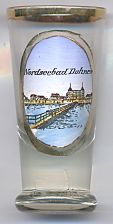
Duhnen also is a city borough of Cuxhaven, located just west of Döse.
It was first mentioned as Dune in a document of 1310/1325. Until 1864 it was part of the Hamburg Amt (district)
Ritzebüttel and then of the Landherrenschaft (manor) Ritzebüttel. In 1873, Duhnen obtained the status of a
rural municipality. In 1902 it was recognised as a seaside resort. Duhnen became part of Cuxhaven in 1935.
[http://cuxpedia.de/index.php?title=Duhnen, https://de.wikipedia.org/wiki/Duhnen]
![[scale]](lineal.jpg)